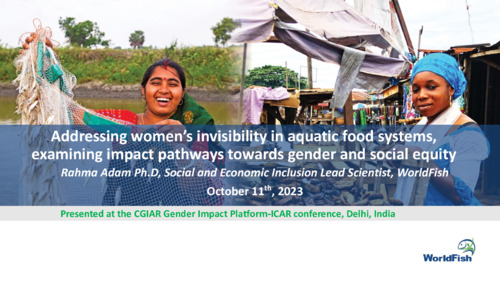Addressing women’s invisibility in aquatic food systems; impact pathways towards gender and social equity
Abstract
Aquatic food systems make significant contributions to sustainable development through generating employment; providing community and household food and nutrition security; and strengthening family well-being, socioeconomic growth, poverty alleviation, climate resilience and environmental sustainability. SDG 5 makes an explicit commitment to “achieve gender equality and empower all women and girls” in their own right. Yet gender inequalities and barriers remain prevalent in rural areas of lowincome countries, including where there is a high reliance on aquatic food systems. Although women make up half of the overall workforce throughout the fisheries and aquaculture value chains, and occupying critical roles, they constitute a disproportionately large percentage of the people engaged in the informal, lowest paid, least stable and least skilled segments of the workforce. Indeed, women participate in all parts of fish food systems, but are most visible in post-harvest processing and trade of fish. This invisibility of women creates a condition in which the role that women play in the aquatic food system is not given much weight by the policymakers, development practitioners, private sector and others. Building on multiple participatory and feminist-ecological methods, we lay out a conceptual framework for aquatic food systems that stipulate five impact pathways that can be used to address gender and social equity in aquatic food systems in low- and middle-income countries across the globe.

